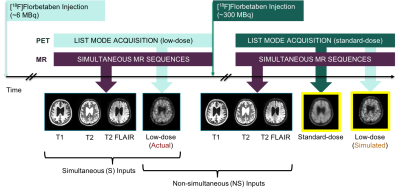Kevin T. Chen1, Olalekan Adeyeri2, Tyler N Toueg3, Elizabeth Mormino3, Mehdi Khalighi1, and Greg Zaharchuk1
1Radiology, Stanford University, Stanford, CA, United States, 2Salem State University, Salem, MA, United States, 3Neurology and Neurological Sciences, Stanford University, Stanford, CA, United States
1Radiology, Stanford University, Stanford, CA, United States, 2Salem State University, Salem, MA, United States, 3Neurology and Neurological Sciences, Stanford University, Stanford, CA, United States
In this study, we aim to investigate whether simultaneity is a requirement for using structural MRI inputs to enhance ultra-low-dose amyloid PET images in a deep neural network. This will increase the utility of ultra-low-dose PET by including data acquired on separate PET and MRI machines.

Figure 1. Sample ultra-low-dose protocol. The participants were scanned in two sessions and the two sets of MR images obtained from the sessions were used in separate neural network trainings to test the effect of simultaneous (S) vs. non-simultaneous (NS) inputs.

Figure 3. Representative amyloid PET images (top: amyloid negative, bottom: amyloid positive) with the corresponding T1 MR images. Both sets of CNN-enhanced ultra-low-dose PET images show greatly reduced noise compared to the ultra-low-dose PET image and resemble the standard-dose PET image. NS: non-simultaneous, S: simultaneous
